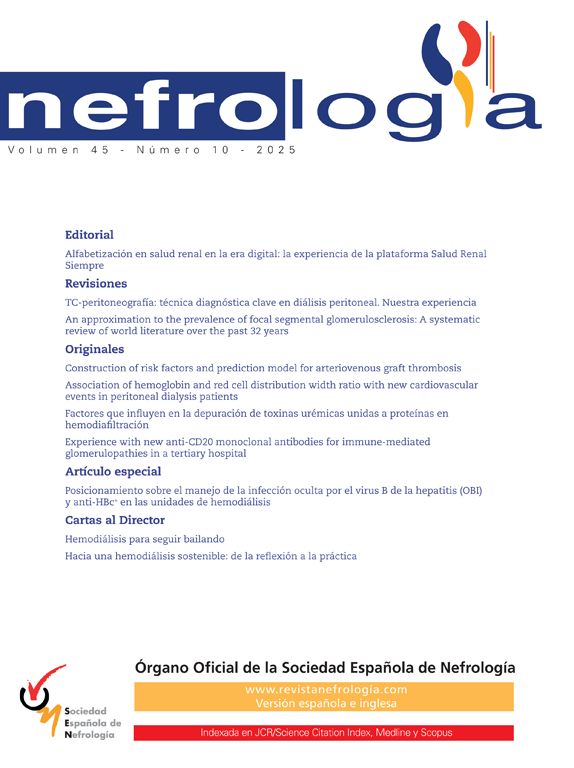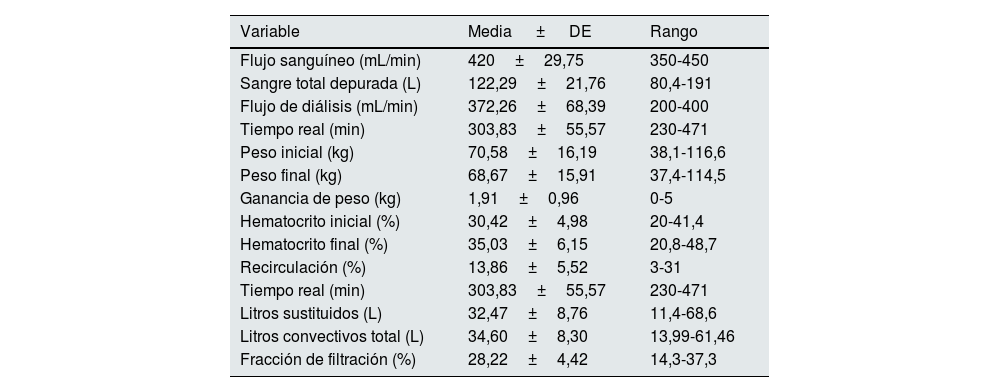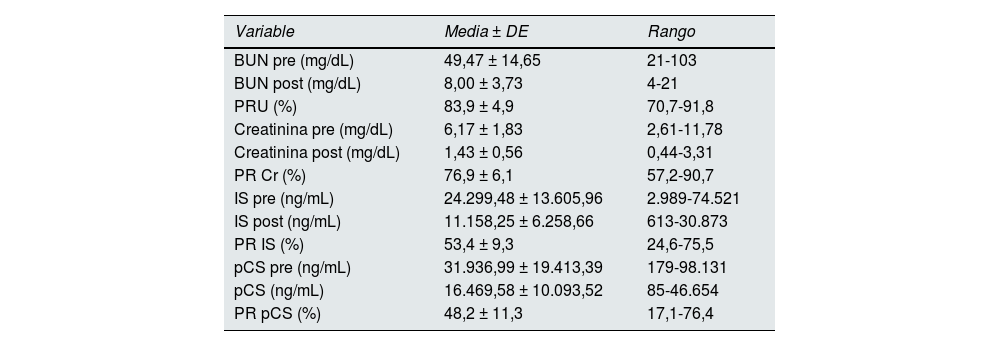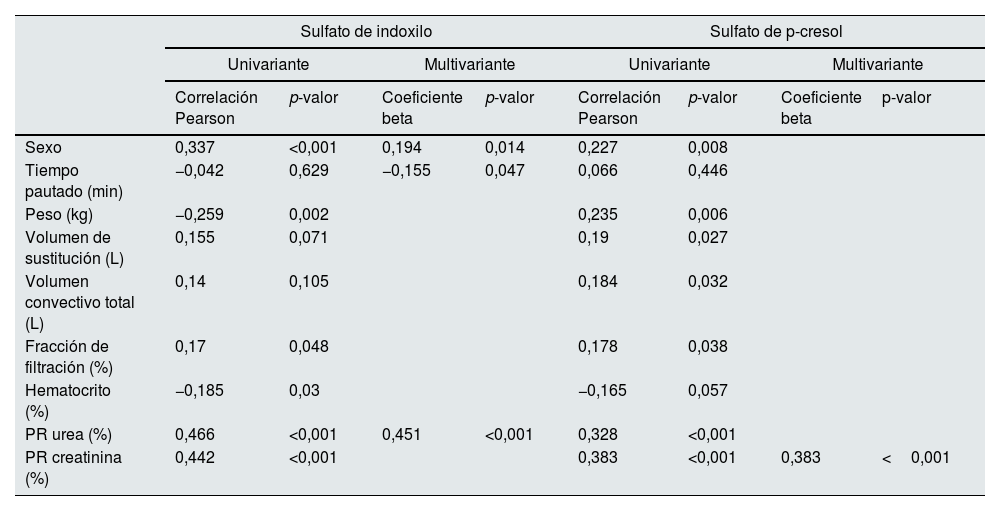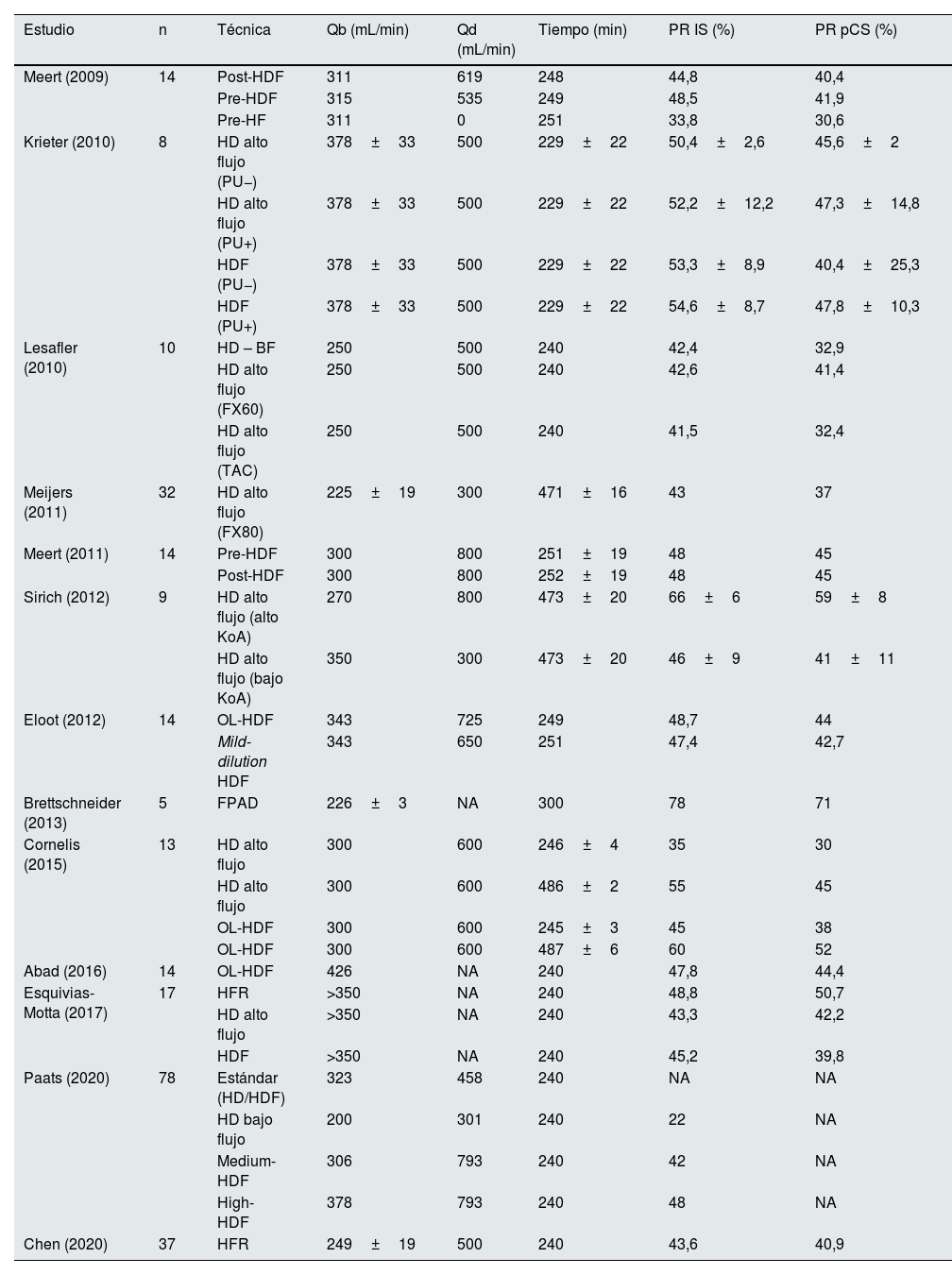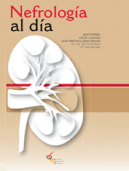Las toxinas urémicas unidas a proteínas (PBUT) presentan una elevada afinidad por la albúmina y se relacionan con un incremento en la morbimortalidad cardiovascular en pacientes en hemodiálisis. Entre ellas, el sulfato de p-cresol (pCS) y el sulfato de indoxilo (IS) destacan por su elevada toxicidad. La hemodiafiltración posdilucional (HDF) es una de la técnica de hemodiálisis que mayores beneficios ha demostrado en la supervivencia de los pacientes en hemodiálisis.
Material y métodosEste estudio observacional, unicéntrico y transversal evaluó la depuración de PBUT en 137 pacientes en HDF posdilucional, analizando los factores que influyen en su eliminación. Se midieron los porcentajes de reducción (PR) de IS y pCS, así como su correlación con parámetros de diálisis y variables clínicas.
ResultadosLos resultados mostraron que el PR medio de IS fue del 53,4±9,3% y el de pCS del 48,2%±11,3%. Se observó una correlación significativa entre el PR de ambas toxinas (r=0,606; p<0,01), lo que indica mecanismos de eliminación similares. Además, el volumen convectivo total mostró una correlación positiva con el PR de pCS (r=0,19; p=0,027) y una correlación débil con el PR de IS (r=0,155; p=0,07). Se encontró una diferencia significativa en la depuración según el sexo, con mayores PR en mujeres (p<0,001 para IS y p=0,008 para pCS).
ConclusionesLa depuración de PBUT es fundamentalmente difusiva. Incrementar todas las variables relacionadas con este principio físico aumentará la eliminación de dichas toxinas. La HDF posdilucional con alto volumen convectivo incrementa discretamente esta depuración. No obstante, los resultados siguen siendo insuficientes, dada la alta toxicidad de estas moléculas. Se requieren nuevas estrategias, como el uso de membranas adsortivas y moléculas competidoras, para optimizar su depuración y reducir el impacto negativo en la salud cardiovascular de los pacientes en hemodiálisis.
Protein-bound uremic toxins (PBUTs) have a high affinity for albumin and they are associated with increased cardiovascular morbidity and mortality in hemodialysis patients. Among them, p-cresyl sulfate (pCS) and indoxyl sulfate (IS) stand out due to their high toxicity. Post-dilution hemodiafiltration (HDF) is one of the dialysis techniques that has shown the greatest benefits in terms of patient survival.
Materials and methodsThis observational, single-center, cross-sectional study evaluated PBUT clearance in 137 patients undergoing post-dilution HDF, analyzing the factors that influence their removal. Reduction ratios (RRs) of IS and pCS were measured, as well as their correlation with dialysis parameters and clinical variables.
ResultsThe mean RR for IS was 53.4%±9.3%, and for pCS, 48.2%±11.3%. A significant correlation was observed between the RR of both toxins (r=0.606; P<0.01), suggesting similar elimination mechanisms. In addition, total convective volume showed a positive correlation with the RR of pCS (r=0.19; P=0.027) and a weak correlation with the RR of IS (r=0.155; P=0.07). A significant difference in clearance was found according to sex, with higher RRs in women (P<0.001 for IS and P=0.008 for pCS).
ConclusionsThe clearance of PBUTs is primarily diffusive. Enhancing all variables related to this physical principle will improve the elimination of these toxins. Post-dilution HDF with high convective volume slightly increases this clearance. However, the results remain insufficient given the high toxicity of these molecules. New strategies, such as the use of adsorptive membranes and competitive molecules, are needed to optimize their removal and reduce the negative cardiovascular impact in hemodialysis patients.
Las toxinas urémicas son clasificadas según sus características fisicoquímicas y su capacidad depurativa mediante técnicas convencionales de hemodiálisis, según la actual clasificación del grupo de trabajo European Uremic Toxins (EUTox)1. De ellas, las toxinas urémicas unidas a proteínas (PBUT) engloban diversos grupos de moléculas2,3 con alta afinidad por las proteínas plasmáticas, mayoritariamente la albúmina4. Estas toxinas se producen tras el metabolismo hepático de precursores formados por el metabolismo de las proteínas dietéticas de la microbiota intestinal; posteriormente, son eliminadas por los riñones mediante secreción tubular5. Las PBUT se han relacionado con un aumento de la morbimortalidad cardiovascular en los pacientes en hemodiálisis6-8. De ellas, el sulfato de p-cresol (pCS) y el sulfato de indoxilo (IS) son las más estudiadas y las que tienen mayor toxicidad demostrada sobre el sistema cardiovascular3. De hecho, hay evidencia para considerar que el pCS tiene el más alto índice de toxicidad urémica (grado 4), que afecta hasta 7 órganos, mientras que el IS tiene un grado de toxicidad 3, con 6 órganos afectos9,10.
Hay una gran variabilidad en el porcentaje de reducción (PR) de PBUT10. Las técnicas convencionales de hemodiálisis mediante hemodiálisis de alto flujo, hemodiafiltración (HDF) posdilucional11 o hemodiálisis expandida12 presentan tasas de depuración inferiores al 55% y 50% para IS y p-CS, respectivamente10. Debido a su pequeño peso molecular y su depuración fundamentalmente difusiva, las técnicas extendidas en el tiempo son la estrategia disponible que mayor depuración alcanza13,14. En la actualidad están en desarrollo otras estrategias, como el uso de moléculas competidoras o el desarrollo de membranas con capacidad adsortiva15.
El objetivo de este estudio fue evaluar la depuración de PBUT en nuestra unidad de diálisis, todos en modalidad de HDF posdilucional, y evaluar los principales factores que influyen en su depuración.
Material y métodosEste estudio observacional, unicéntrico y transversal se llevó a cabo en una cohorte de analítica mensual de la unidad de hemodiálisis crónica. Se incluyeron 137 pacientes (47 mujeres, 34%) con una edad media de 70±17 (rango: 21-96), que se mantuvieron estables mediante HDF durante un tiempo medio de 44 ± 54 meses (rango: 3-315). Se incluyeron pacientes adultos en pauta estándar de 3 sesiones/semana de 4-5h de duración y pacientes en pauta nocturna de 8h de duración (117 y 20, respectivamente). Se excluyeron aquellos pacientes en condiciones agudas o inestables. Las enfermedades renales de base fueron: nefroangioesclerosis (16), nefropatía diabética (17), glomerulonefritis (14), enfermedad sistémica (14), no filiada (14), nefritis tubulointersticial (12), urológica (11) y poliquistosis renal (3). Todos los pacientes firmaron el consentimiento informado. El estudio fue aprobado por el Comité de Ética local y se desarralló de acuerdo con la Declaración de Helsinki.
Todos los pacientes acudieron a una sesión habitual de diálisis en modalidad HDF posdilucional con los siguientes parámetros: baño de diálisis con bicarbonato, flujo sanguíneo (Qb) 421±30mL/min, flujo del dializado (Qd) 400mL/min y tiempo de diálisis (Td) 304 ± 56 minutos (rango: 240-480). La ultrafiltración neta de líquido se configuró individualmente, según las necesidades clínicas del paciente. El acceso vascular fue a través de fístula arteriovenosa en 74 pacientes, en 7 a través de fístula arteriovenosa protésica y en 56 con un catéter tunelizado. La anticoagulación utilizada fue heparina de bajo peso molecular (tinzaparina) en 57,6% de los pacientes, heparina sódica en el 30,7% y el restante 11,7% se dializó sin anticoagulación. Se utilizaron monitores de diálisis Fresenius 5008 CorDiax o 6008 CAREsystem (Fresenius, Bad Homburg, Alemania). Se usaron las siguientes membranas de diálisis: 72 FX60 (Fresenius, Bad Homburg, Alemania), 39 Clearum (Bellco, Mirandola, Italia), 12 CorAL60 (Fresenius, Bad Homburg, Alemania), 12 Solacea (Nipro, Osaka, Japón) y 2 FX50 (Fresenius, Bad Homburg, Alemania).
Los parámetros de diálisis recogidos fueron los siguientes: duración real, dializador, Qb, índice de recirculación medido por el módulo de temperatura, hematocrito inicial y final medido de forma automática por el biosensor BVM, pesos corporales inicial y final, volumen total de sangre procesada y volumen de reposición.
Se tomaron muestras de sangre para análisis de cada paciente. Las mediciones de laboratorio incluyeron concentraciones de urea (peso molecular [PM] 60), creatinina (PM 113), en suero al inicio y al final de cada sesión para calcular la tasa de reducción (RR) de estos solutos. También se evaluaron las toxinas urémicas unidas a proteínas, pCS (PM 108) e IS (PM 213). Las concentraciones finales de IS y pCS se corrigieron para el grado de hemoconcentración y el volumen de distribución (volumen extracelular aproximado) de acuerdo con Bergström y Wehle16.
La urea y la creatinina se midieron por espectrometría de absorción molecular en el analizador Atellica Solution (Siemens Healthineers, Tarrytown, NY, EE. UU.). El IS y el pCS se midieron en suero mediante cromatografía líquida-espectrometría de masas (LC-MS), según metodología especificada en estudio previo17.
Los resultados se expresaron como media aritmética±desviación estándar. Para el análisis de la significación estadística de los parámetros cuantitativos analizamos la prueba t de Student para datos independientes. Para identificar los factores que predicen la mayor o menor depuración de PBUT se elaboraron modelos de regresión logística uni- y multivariante. Se calculó el coeficiente de correlación de Pearson para evaluar la relación lineal entre el PRIS y PR pCS y las diferentes variables que mostraron significación. Los valores de p<0,05 se consideraron estadísticamente significativos. Los análisis se realizaron utilizando el programa SPSS versión 23 (SPSS, Chicago, IL, EE. UU.).
ResultadosTodas las sesiones se realizaron sin incidencias reseñables. Las variables relacionadas con la técnica de diálisis se exponen en la tabla 1: Qb, volumen total de sangre procesada, duración real, índice de recirculación del acceso vascular, peso inicial, peso final, ganancia de peso, hematocrito inicial y final, volumen de reposición en HDF, volumen convectivo total (volumen de reposición más volumen ultrafiltrado) y el cálculo de la fracción de filtración (FF).
Variables relacionadas con la sesión de diálisis
| Variable | Media ± DE | Rango |
|---|---|---|
| Flujo sanguíneo (mL/min) | 420±29,75 | 350-450 |
| Sangre total depurada (L) | 122,29±21,76 | 80,4-191 |
| Flujo de diálisis (mL/min) | 372,26±68,39 | 200-400 |
| Tiempo real (min) | 303,83±55,57 | 230-471 |
| Peso inicial (kg) | 70,58±16,19 | 38,1-116,6 |
| Peso final (kg) | 68,67±15,91 | 37,4-114,5 |
| Ganancia de peso (kg) | 1,91±0,96 | 0-5 |
| Hematocrito inicial (%) | 30,42±4,98 | 20-41,4 |
| Hematocrito final (%) | 35,03±6,15 | 20,8-48,7 |
| Recirculación (%) | 13,86±5,52 | 3-31 |
| Tiempo real (min) | 303,83±55,57 | 230-471 |
| Litros sustituidos (L) | 32,47±8,76 | 11,4-68,6 |
| Litros convectivos total (L) | 34,60±8,30 | 13,99-61,46 |
| Fracción de filtración (%) | 28,22±4,42 | 14,3-37,3 |
%: porcentaje; DE: desviación estándar; kg: kilogramos; L: litros; min: minutos; mL: mililitros.
Las concentraciones séricas de las toxinas urémicas (BUN, creatinina, IS y pCS), así como el porcentaje de reducción se exponen en la tabla 2. El PR de IS fue de 53,4±9,3% (rango: 24-76) y el de pCS fue de 48,2 ± 11,3% (rango: 17-76).
Concentraciones séricas de toxinas urémicas
| Variable | Media ± DE | Rango |
|---|---|---|
| BUN pre (mg/dL) | 49,47 ± 14,65 | 21-103 |
| BUN post (mg/dL) | 8,00 ± 3,73 | 4-21 |
| PRU (%) | 83,9 ± 4,9 | 70,7-91,8 |
| Creatinina pre (mg/dL) | 6,17 ± 1,83 | 2,61-11,78 |
| Creatinina post (mg/dL) | 1,43 ± 0,56 | 0,44-3,31 |
| PR Cr (%) | 76,9 ± 6,1 | 57,2-90,7 |
| IS pre (ng/mL) | 24.299,48 ± 13.605,96 | 2.989-74.521 |
| IS post (ng/mL) | 11.158,25 ± 6.258,66 | 613-30.873 |
| PR IS (%) | 53,4 ± 9,3 | 24,6-75,5 |
| pCS pre (ng/mL) | 31.936,99 ± 19.413,39 | 179-98.131 |
| pCS (ng/mL) | 16.469,58 ± 10.093,52 | 85-46.654 |
| PR pCS (%) | 48,2 ± 11,3 | 17,1-76,4 |
DE, desviación estándar; BUN, nitrógeno ureico en sangre; pre, prediálisis; post, posdiálisis; mg, miligramos; dL, decilitros; ng, nanogramos; mL, mililitros; PR, porcentaje de reducción; U, urea; Cr, creatinina; IS, sulfato de indoxilo; pCS, sulfato de p-cresol. Las concentraciones finales pCS e IS se corrigieron para el grado de hemoconcentración y el volumen de distribución (volumen extracelular aproximado) de acuerdo con Bergström y Wehle (13).
La mayor asociación encontrada fue entre los PR de ambas PBUT analizadas (r=0,606; p<0,01), lo que evidencia que ambas toxinas se eliminan por mecanismos similares.
En el análisis univariante se observa que, en el IS, la mayor correlación se dio con el porcentaje de reducción de urea y creatinina (fig. 1), seguidos del género (fig. 2), peso, hematocrito (fig. 1 suplementaria del Appendix B) y el volumen convectivo expresado como FF (fig. 2 suplementaria del Appendix B); sin embargo, no alcanzó significación estadística con la albúmina, el tiempo de diálisis, el volumen de sustitución ni el volumen convectivo total (tabla 3).
Análisis de correlación
| Sulfato de indoxilo | Sulfato de p-cresol | |||||||
|---|---|---|---|---|---|---|---|---|
| Univariante | Multivariante | Univariante | Multivariante | |||||
| Correlación Pearson | p-valor | Coeficiente beta | p-valor | Correlación Pearson | p-valor | Coeficiente beta | p-valor | |
| Sexo | 0,337 | <0,001 | 0,194 | 0,014 | 0,227 | 0,008 | ||
| Tiempo pautado (min) | −0,042 | 0,629 | −0,155 | 0,047 | 0,066 | 0,446 | ||
| Peso (kg) | −0,259 | 0,002 | 0,235 | 0,006 | ||||
| Volumen de sustitución (L) | 0,155 | 0,071 | 0,19 | 0,027 | ||||
| Volumen convectivo total (L) | 0,14 | 0,105 | 0,184 | 0,032 | ||||
| Fracción de filtración (%) | 0,17 | 0,048 | 0,178 | 0,038 | ||||
| Hematocrito (%) | −0,185 | 0,03 | −0,165 | 0,057 | ||||
| PR urea (%) | 0,466 | <0,001 | 0,451 | <0,001 | 0,328 | <0,001 | ||
| PR creatinina (%) | 0,442 | <0,001 | 0,383 | <0,001 | 0,383 | <0,001 | ||
%: porcentaje; kg: kilogramos; L: litros; Min: minutos; PR: porcentaje de reducción.
Con respecto al pCS, la mayor correlación se observó también con el porcentaje de reducción de urea y creatinina (fig. 1), seguidos del género (fig. 2), peso, hematocrito (fig. 1 suplementaria del Appendix B), volumen de sustitución, volumen convectivo total y FF (fig. suplementaria 2 del Appendix B); tampoco alcanzó significación estadística con la albúmina y el tiempo de diálisis (tabla 3). A diferencia del PR de IS, sí muestra correlación estadísticamente significativa con el volumen de sustitución y con el volumen convectivo total. También presentó correlación positiva con el peso final, pero no con el hematocrito final.
En el análisis multivariante mediante regresión lineal, solo 3variables permanecieron como predictoras independientes del PR de IS: el sexo, el tiempo pautado y el PRU (tabla 3). De esta forma, el análisis multivariante del PR de IS nos brinda la siguiente fórmula:
PR IS=PRU + [(0,194 × Sexo) +(−0,155 × Tiempo pautado) + (0,451 × PRurea) − 16,5]
Donde, sexo se codificó como 0 para varones y 1 para mujeres, el tiempo pautado se expresa en minutos y el PRU en porcentaje. Este modelo presenta un coeficiente de correlación múltiple (R) de 0,531, con un coeficiente de determinación (R2) de 0,282, lo que indica que el 28,2% de la variabilidad del PR de IS es explicado por estas 3variables.
Por otra parte, respecto al PR de pCS en el análisis multivariante, solo permaneció estadísticamente significativa su correlación con el PR de creatinina. En este caso, a diferencia del PR de IS, tuvo más valor estadístico el PR de creatinina que el PRU.
DiscusiónLa depuración de las toxinas urémicas unidas a proteínas mediante HDF-OL con altos volúmenes convectivos en nuestra unidad se sitúa alrededor del 53% y del 48% para el IS y el pCS, respectivamente; resultados similares a los publicados en la literatura (tabla 4). El análisis de asociación mostró una depuración directamente proporcional con la depuración de pequeñas moléculas, lo que evidencia la depuración fundamentalmente difusiva de las PBUT.
Porcentajes de reducción de toxinas urémicas unidas a proteínas de los principales estudios publicados
| Estudio | n | Técnica | Qb (mL/min) | Qd (mL/min) | Tiempo (min) | PR IS (%) | PR pCS (%) |
|---|---|---|---|---|---|---|---|
| Meert (2009) | 14 | Post-HDF | 311 | 619 | 248 | 44,8 | 40,4 |
| Pre-HDF | 315 | 535 | 249 | 48,5 | 41,9 | ||
| Pre-HF | 311 | 0 | 251 | 33,8 | 30,6 | ||
| Krieter (2010) | 8 | HD alto flujo (PU−) | 378±33 | 500 | 229±22 | 50,4±2,6 | 45,6±2 |
| HD alto flujo (PU+) | 378±33 | 500 | 229±22 | 52,2±12,2 | 47,3±14,8 | ||
| HDF (PU−) | 378±33 | 500 | 229±22 | 53,3±8,9 | 40,4±25,3 | ||
| HDF (PU+) | 378±33 | 500 | 229±22 | 54,6±8,7 | 47,8±10,3 | ||
| Lesafler (2010) | 10 | HD – BF | 250 | 500 | 240 | 42,4 | 32,9 |
| HD alto flujo (FX60) | 250 | 500 | 240 | 42,6 | 41,4 | ||
| HD alto flujo (TAC) | 250 | 500 | 240 | 41,5 | 32,4 | ||
| Meijers (2011) | 32 | HD alto flujo (FX80) | 225±19 | 300 | 471±16 | 43 | 37 |
| Meert (2011) | 14 | Pre-HDF | 300 | 800 | 251±19 | 48 | 45 |
| Post-HDF | 300 | 800 | 252±19 | 48 | 45 | ||
| Sirich (2012) | 9 | HD alto flujo (alto KoA) | 270 | 800 | 473±20 | 66±6 | 59±8 |
| HD alto flujo (bajo KoA) | 350 | 300 | 473±20 | 46±9 | 41±11 | ||
| Eloot (2012) | 14 | OL-HDF | 343 | 725 | 249 | 48,7 | 44 |
| Mild-dilution HDF | 343 | 650 | 251 | 47,4 | 42,7 | ||
| Brettschneider (2013) | 5 | FPAD | 226±3 | NA | 300 | 78 | 71 |
| Cornelis (2015) | 13 | HD alto flujo | 300 | 600 | 246±4 | 35 | 30 |
| HD alto flujo | 300 | 600 | 486±2 | 55 | 45 | ||
| OL-HDF | 300 | 600 | 245±3 | 45 | 38 | ||
| OL-HDF | 300 | 600 | 487±6 | 60 | 52 | ||
| Abad (2016) | 14 | OL-HDF | 426 | NA | 240 | 47,8 | 44,4 |
| Esquivias-Motta (2017) | 17 | HFR | >350 | NA | 240 | 48,8 | 50,7 |
| HD alto flujo | >350 | NA | 240 | 43,3 | 42,2 | ||
| HDF | >350 | NA | 240 | 45,2 | 39,8 | ||
| Paats (2020) | 78 | Estándar (HD/HDF) | 323 | 458 | 240 | NA | NA |
| HD bajo flujo | 200 | 301 | 240 | 22 | NA | ||
| Medium-HDF | 306 | 793 | 240 | 42 | NA | ||
| High-HDF | 378 | 793 | 240 | 48 | NA | ||
| Chen (2020) | 37 | HFR | 249±19 | 500 | 240 | 43,6 | 40,9 |
FPAD: fractionated plasma separation and adsorption technique; HD: hemodiálisis; HDF-OL: hemodiafiltración online;
HF: hemofiltración; HFR: hemodiafiltración con reinfusión endógena; IS: sulfato de indoxilo; min: minutos; mL: mililitros; n: número; NA: no aparece; pCS: sulfato de p-cresol; PR: porcentaje de reducción; pre-HDF: hemodiafiltración predilucional; PU: membrana PUREMA; Qb: flujo sanguíneo; Qd: flujo de diálisis; TAC: triacetato de celulosa.
Estas toxinas presentan un alto grado de unión a la albúmina con hasta el 95% de unión para el IS y el pCS18,19. El ácido 3-carboxi-4-metil-5-propil-2-furan-propanoico es la PBUT con mayor grado de unión documentado (99-100%)19. Estas toxinas se unen a la albúmina en los sitios de unión Sudlow I y II; el sitio Sudlow II es el predominante para el IS y el pCS18. Este alto grado de unión proteica limita su depuración con las técnicas convencionales de hemodiálisis a pesar de ser moléculas de pequeño tamaño molecular15.
La tabla 4 recoge los distintos trabajos que han analizado la depuración de PBUT mediante distintas técnicas de hemodiálisis. La hemodiálisis de bajo flujo alcanza PR para IS del 22% con flujo sanguíneo (Qb) y del dializado (Qd) de 200mL/min y 300mL/min, respectivamente20. La hemodiálisis de alto flujo alcanza en una sesión convencional de 4 horas unos PR de IS y de pCS en torno a 33-52% y 27-47%13,21-23 (tabla 4). La hemodiafiltración predilucional consigue un PR del 48% para IS y del 41-45% para pCS24,25, mientras que la HDF posdilucional consigue PR similares o con discretos aumento hasta PR del 45-55% y del 38-48% para el IS y el pCS, respectivamente11,13,23,26,27. Las técnicas extendidas en el tiempo (8 horas) consiguen PR de IS y pCS del 60% y 52, respectivamente, con hemodiafiltración posdilucional y del 43-55% y 37-45%, respectivamente, con hemodiálisis de alto flujo13,28 y hasta 66% y 59%, respectivamente, con hemodiálisis de alto flujo con membranas de alto KoA14, debido a la disociación constante y a la mayor disponibilidad de la fracción libre de las PBUT13. La disparidad de resultados en la literatura podría estar explicada por la heterogeneidad de variables que influyen en la depuración de pequeñas moléculas: Qb, Qd y tiempo, así como por el escaso número de pacientes estudiados, lo que podría impedir su validación externa (tabla 4). La hemodiálisis expandida no alcanza PR superiores a las técnicas previas12. Este estudio presenta PR de IS y pCS del 53% y 48%, respectivamente, mediante HDF-OL con alto volumen convectivo, acorde con los trabajos publicados (tabla 4). En nuestro caso, la cohorte nocturna no alcanza PR superiores al grupo diurno, probablemente debido al menor Qd pautado (200mL/min) comparado con los trabajos mencionados de Cornelis et al.13 y Sirich et al.14, que presentan Qd de 600mL/min y 800mL/min, respectivamente, así como la diferencia entre ambas cohortes en nuestro trabajo (20 vs. 117). Más recientemente, nuestro grupo ha evaluado el posible valor de la hemoadsorción sobre la depuración de diversas toxinas urémicas con diversas modalidades de hemodiálisis. De entre todas las modalidades, la OL-HDF fue la técnica que mayor reducción de IS (55%) y de pCS (51%) alcanzó, respecto a la hemodiálisis de bajo o alto flujo (con un porcentaje de reducción de alrededor de un 5% inferior), sin observar diferencias en la depuración de las PBUT cuando se añadía el cartucho de hemoadsorción en ninguna de las 3modalidades de tratamiento estudiadas29.
El análisis de correlación muestra una relación de la depuración de IS y pCS con la depuración de toxinas urémicas de pequeño peso molecular, debido a que la difusión es el principal principio depurativo de su eliminación10,13 (fig. 1). De esta forma, aumentando aquellas variables que incrementan la capacidad difusiva de la técnica de hemodiálisis, como el Qb, Qd o el tiempo o frecuencia de terapia, se aumenta de forma directamente proporcional la depuración de las PBUT. Además, las diferencias encontradas en la depuración de PBUT entre hombres y mujeres (fig. 2 y fig. suplementaria 1 del Appendix B) refieren una relación inversamente proporcional con el volumen de distribución, ya que este generalmente es menor en el sexo femenino30. La HDF posdilucional aumenta la depuración de PBUT por el discreto aumento que aporta en la depuración de pequeñas moléculas (PRU y PR de creatinina), más que por el efecto convectivo31,32, tal y como ya observaron Abad et al.26 (fig. suplementaria 2 del Appendix B).
En la actualidad, se están desarrollando distintas estrategias que aumentan la depuración de las toxinas unidas a proteínas. El uso durante la sesión de diálisis de moléculas competidoras parece ser la más disponible en el ámbito clínico33. Así, se ha demostrado en diversos trabajos invitro el uso de triptófano, furosemida e ibuprofeno34, el último de los cuales es el de mayor capacidad competitiva para el IS y el pCS35. También se estudia el uso de ácidos salvianólicos36 y emulsiones lipídicas (IntralipidTM, Fresenius KABI SSPC, Jiangsu, China) en modelos murinos37, sin datos hasta la fecha en humanos ni sobre su posible seguridad38. El único competidor usado clínicamente en pacientes ha sido el ibuprofeno39 con aumento del aclaramiento desde 6 hasta 20,2mL/min y del 4,4 hasta el 14,9 para el IS y pCS, respectivamente. Así, nuestro grupo evidenció un aumento del 14,2% y del 12,9% en los porcentajes de reducción del IS y del pCS tras la infusión en la rama arterial durante una hora, lo que alcanza un PR del 58,8% y del 54,6%, respectivamente40. Otra de las estrategias es el desarrollo de membranas de diálisis capaces de adsorber las PBUT, mediante la incorporación de partículas adsorbentes como el carbón activo38, zeolitas41 o estructuras metaloorgánicas de circonio42. Además, se postula la combinación de ambas estrategias con membranas que presentes moléculas competidoras adheridas a la vertiente luminal43. Sin embargo, no se dispone de datos clínicos con estrategias adsortivas hasta la fecha.
Otra de las estrategias reportadas en la literatura para reducir la concentración de PBUT es la intervención dietética o el uso de adsorbentes orales44. Respecto a la modificación dietética, en el estudio MEDIKA, prospectivo y cruzado, realizado en pacientes con enfermedad renal crónica avanzada, se evidenció que la dieta muy baja en proteínas (proteínas 0,3-0,5g/kg al día, junto con ketoanálogos), seguida de la dieta mediterránea (proteínas 0,7-0,8g/kg al día con predominio de origen vegetal), disminuía la concentración sérica de IS y de pCS en comparación con la dieta libre (1g/kg al día con predominio de origen animal)45. Los autores justifican este efecto por un doble mecanismo: primero, una reducción en el aporte proteico, sustrato inicial de las toxinas urémicas unidas a proteínas y, segundo, un efecto modulatorio sobre la microbiota intestinal, con una reducción de proteobacterias y un aumento de especies sacarolíticas y formadoras de butirato43. En cuanto al uso de adsorbentes orales como quelantes de los productos del metabolismo de la microbiota intestinal, solo existen datos sobre el uso del Kremezin® (carbón activado esférico, AST-120; Kureha Chemical Industry Co Ltd, Tokio, Japón) en pacientes con enfermedad renal crónica avanzada46, en quienes se observó una reducción de IS dependiente de dosis, y en pacientes en hemodiálisis47 con reducciones de IS total y pCS total del 45% y 31%, respectivamente.
Este trabajo presenta algunas limitaciones destacables. Primero, la ausencia de un grupo control con otra modalidad de hemodiálisis impide una comparación directa del efecto de la HDF posdilucional. Segundo, a pesar de la influencia del tiempo de la diálisis en la capacidad difusiva de estas moléculas, la gran diferencia entre las 2cohortes presentadas (117 vs. 20 pacientes) podría explicar la ausencia de diferencias estadísticamente significativas, así como la disparidad con los resultados de otros trabajos. Tercero, solo se ha medido la depuración de 2PBUT (IS y pCS), lo que dificulta la generalización hacia otras toxinas urémicas unidas a proteínas. Por último, aunque el modelo multivariante explica una parte de variabilidad de la depuración del IS, otros factores no considerados podrían influir en los resultados. No obstante, la principal fortaleza de este trabajo es que representa la mayor cohorte estudiada sobre la depuración de las PBUT. Además, nuestros resultados refuerzan la idea del uso de altos flujos de sangre y de dializado, junto con un aumento del tiempo de terapia dentro de lo posible de cada unidad, con el fin de mejorar la capacidad difusiva de estas toxinas urémicas.
En resumen, la HDF en línea posdilucional con altos volúmenes convectivos alcanza tasas de depuración de toxinas urémicas unidas a proteínas similares a las reportadas por otros grupos, pero superiores a las obtenidas con hemodiálisis de alto flujo o hemodiálisis extendida. Sin embargo, estos resultados son insuficientes, dada la toxicidad demostrada de estas toxinas, causantes del aumento de la mortalidad cardiovascular en pacientes en hemodiálisis. Para optimizar su depuración, futuros estudios deberán evaluar estrategias combinadas, como la integración de membranas adsortivas con las técnicas de hemodiálisis o el uso de moléculas competidoras.
FinanciaciónLa presente investigación no ha recibido ayudas específicas provenientes de agencias del sector público, sector comercial ni entidades sin ánimo de lucro.
Conflicto de interesesLos autores declaran no haber recibido soporte financiero para este proyecto. FM ha recibido honorarios de Amgen, Baxter, Fresenius Medical Care, Medtronic, Nipro, Palex y Vifor. El resto de los autores declaran no tener ningún conflicto de intereses.
Queremos manifestar nuestro agradecimiento a todos los pacientes que han participado, así como a todo el personal de la Sección de Diálisis del Hospital Clínic de Barcelona por su colaboración en este estudio.
Figura suplementaria 1. Gráfico de dispersión de los porcentajes de reducción del indoxil sulfato con el peso final (A) y el hematocrito (B) así como del p-cresil sulfato (B y D, respectivamente). Se muestra los coeficientes de Pearson y el p-valor correspondiente.
Figura suplementaria 2. Gráfico de dispersión de los porcentajes de reducción del indoxil sulfato con el volumen de sustitución (A) y la fracción de filtración (B) así como del p-cresil sulfato (B y D, respectivamente). Se muestra los coeficientes de Pearson y el p-valor correspondiente.

